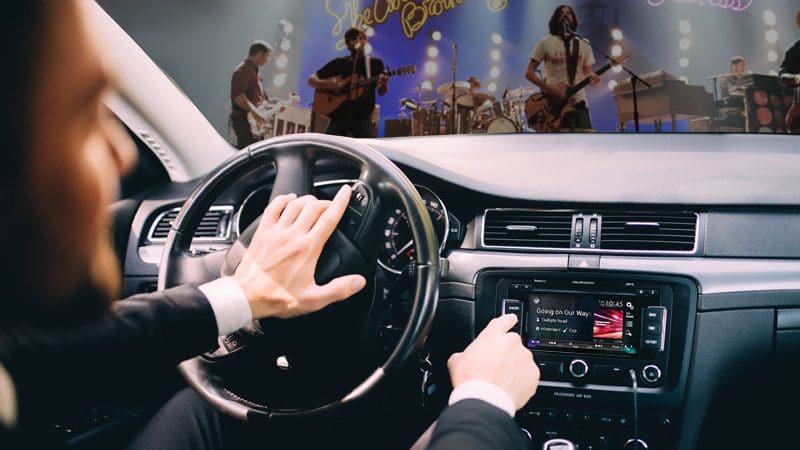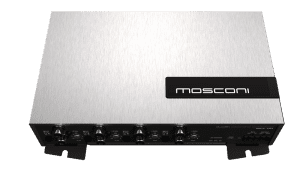 If you talk to someone who is truly passionate about the accuracy of their sound system, then terms like tonal balance, soundstage and stereo imaging are bound to be part of the discussion. Each of these terms describes a different aspect of how your audio system reproduces music. For the listening experience to be truly magical, each element needs to be realistic. Let’s look at stereo imaging in detail.
If you talk to someone who is truly passionate about the accuracy of their sound system, then terms like tonal balance, soundstage and stereo imaging are bound to be part of the discussion. Each of these terms describes a different aspect of how your audio system reproduces music. For the listening experience to be truly magical, each element needs to be realistic. Let’s look at stereo imaging in detail.
What You Hear at a Live Performance
 Listening to a band in a small club is very different from a performance in a stadium or outdoor setting. When the performance requires a great deal of amplification, it’s up to the person behind the mixing console to determine where the sounds from each performer come from. In most cases, there are two large banks of speakers, one on each side of the stage. If the sound technician decides that the sound from the guitarist on the left side of the stage should come primarily from the left speakers, and the sound from the bassist on the opposite side of the stage should come from the right speakers, there will be some sense of realism to the performance. If everything is mixed in mono so that the music is as loud as possible, well, it might sound great, but you won’t be able to discern where each performer is on the stage from the sound alone.
Listening to a band in a small club is very different from a performance in a stadium or outdoor setting. When the performance requires a great deal of amplification, it’s up to the person behind the mixing console to determine where the sounds from each performer come from. In most cases, there are two large banks of speakers, one on each side of the stage. If the sound technician decides that the sound from the guitarist on the left side of the stage should come primarily from the left speakers, and the sound from the bassist on the opposite side of the stage should come from the right speakers, there will be some sense of realism to the performance. If everything is mixed in mono so that the music is as loud as possible, well, it might sound great, but you won’t be able to discern where each performer is on the stage from the sound alone.
At a small live performance, especially one with minimal amplification, the instruments themselves are responsible for what you hear. A choir or an orchestra are great examples of unamplified performances. Don’t let the stereotype of “fancy music” fool you; every genre of music, save for maybe dance and EDM, has opportunities for live, acoustic performances. How does the listening experience differ?
 In an acoustic performance, the sound you hear from each instrument originates at the instrument. The sound could be that of a guitar, an upright bass or a set of drums. Drums are a great example. In most configurations, the high-hat and snare drum are to the left of the drummer, the ride cymbal and the floor tom are on the right. The small and medium toms and the bass drum are usually centralized. If you are listening to a drummer, you can see and hear each cymbal and drum as he or she plays it.
In an acoustic performance, the sound you hear from each instrument originates at the instrument. The sound could be that of a guitar, an upright bass or a set of drums. Drums are a great example. In most configurations, the high-hat and snare drum are to the left of the drummer, the ride cymbal and the floor tom are on the right. The small and medium toms and the bass drum are usually centralized. If you are listening to a drummer, you can see and hear each cymbal and drum as he or she plays it.
The introduction to Dire Straits’ “Money for Nothing” is a great example of a drum kit recorded in stereo. Maybe the size of the kit is a little large relative to the rest of the performance, but you can certainly get a sense of where each drum or cymbal is on the soundstage relative to one another. Being able to pick out the placement of each instrument in the listening environment is known as stereo imaging.
Locations for Excellent Stereo Imaging
 Put on a set of headphones and listen to your favorite recordings. Whether it’s a live performance or computer-created effects in the latest pop music, using different amounts of information in the left and right channels has the effect of placing sounds in different locations from left to right. Many audiophiles strive to perfect the accuracy with which their sound systems reproduce and focus sounds on the soundstage. A sound system with great imaging will be able to isolate instruments and performers very accurately. When a system has excellent imaging, each sound is often described to have a sense of space around it. This space separates one sound from another.
Put on a set of headphones and listen to your favorite recordings. Whether it’s a live performance or computer-created effects in the latest pop music, using different amounts of information in the left and right channels has the effect of placing sounds in different locations from left to right. Many audiophiles strive to perfect the accuracy with which their sound systems reproduce and focus sounds on the soundstage. A sound system with great imaging will be able to isolate instruments and performers very accurately. When a system has excellent imaging, each sound is often described to have a sense of space around it. This space separates one sound from another.
Stereo Imaging in Your Vehicle
When it comes to creating excellent stereo imaging in a car, several significant challenges need addressing. First and foremost, without some amount of signal processing, the driver is going to hear the speakers on the left side of the vehicle before the speakers on the right, simply due to his or her proximity to them. For the same reason, those speakers will seem to be louder. These issues wreak havoc with our ability to create a realistic soundstage and accurate imaging. So, what solutions are available?
 Using a Digital Signal Processor (DSP), your installer can apply a delay to the speakers closest to the listener so that the sound of each speaker in the vehicle arrives at the listening position simultaneously. Likewise, the installer or tuner can reduce the output level of these speakers so that all the speakers have the same relative volume level at the listening position. Now, sounds that are equal in both channels will come from a location between the speakers, and everything will be distributed nicely across the soundstage.
Using a Digital Signal Processor (DSP), your installer can apply a delay to the speakers closest to the listener so that the sound of each speaker in the vehicle arrives at the listening position simultaneously. Likewise, the installer or tuner can reduce the output level of these speakers so that all the speakers have the same relative volume level at the listening position. Now, sounds that are equal in both channels will come from a location between the speakers, and everything will be distributed nicely across the soundstage.
How Can Imaging Be Improved?
If you are looking for incredible realism and accuracy, the next step is to apply equalization to each channel of the system so that we hear the same amount of information from the left and right speakers. Once executed properly, sounds will become more focused on the soundstage and seem to be more stable. The result is impressive and awe-inspiring.
Are There Any Drawbacks to DSP Tuning?
 The process described above is called a “one seat tune.” This configuration means that each speaker in the system is optimized for a single seat in the car or truck. If you sit in the passenger seat, the tonal balance will be mediocre and all the sound will seem to come from the far right speaker. Is there a solution? Well, at the time of writing, not really. But, there will be very soon. Several companies have signal processors coming to market very shortly that include an upmixer. These processors analyze the content in the stereo recording and then output a left, center and right signal that can place sounds accurately for both the driver and the passenger in the vehicle. Using an upmixer does require that the vehicle has a center channel, and the tuning process is much different to make these systems work. The result is that everyone in the car can enjoy a realistic listening experience from any seat, even in the back.
The process described above is called a “one seat tune.” This configuration means that each speaker in the system is optimized for a single seat in the car or truck. If you sit in the passenger seat, the tonal balance will be mediocre and all the sound will seem to come from the far right speaker. Is there a solution? Well, at the time of writing, not really. But, there will be very soon. Several companies have signal processors coming to market very shortly that include an upmixer. These processors analyze the content in the stereo recording and then output a left, center and right signal that can place sounds accurately for both the driver and the passenger in the vehicle. Using an upmixer does require that the vehicle has a center channel, and the tuning process is much different to make these systems work. The result is that everyone in the car can enjoy a realistic listening experience from any seat, even in the back.
Experience Your Music with Amazing Detail
If you haven’t heard a car audio system with excellent imaging and staging, visit your local mobile enhancement retailer today and ask for a demo. Most shops have a demo vehicle or two that are set up to show you what they offer. Once you hear a car with amazing imaging, you’ll want your sound system to be the same. Ask the sales team what options are available for your vehicle.
This article is written and produced by the team at www.BestCarAudio.com. Reproduction or use of any kind is prohibited without the express written permission of 1sixty8 media.